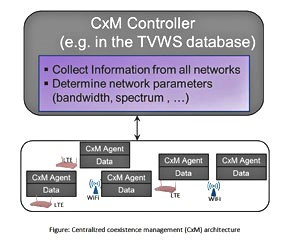BY GOLNAZ FARHADI
Member of Research Staff
Fujitsu Laboratories of America
www.fujitsu.com/us/
The explosive mobile data traffic driven by the popularity of video, social media, and Internet gaming across a range of high-end devices such as smartphones and tablets has created a tremendous strain on wireless networks and accentuated the problem of spectrum shortage for commercial broadband access. However, this scarcity is mostly an artifact of the fixed spectrum assignment policy, as a large portion of the spectrum assigned to wireless carriers is sporadically used. This vast amount of underused spectrum creates a valuable opportunity to enhance mobile broadband experience by spectrum sharing and dynamic spectrum access to the bands not being used (a.k.a. white spaces) at a given location and time.
The digital switchover has yielded a considerable amount of vacant spectrum in the TV band and has become one of the first opportunities to adopt and implement dynamic spectrum models via cognitive radio technologies (specifically geo-location database). Cognitive indicates a network process that can perceive current network conditions, and plan and decide based on those conditions. The FCC in the US has developed a set of regulations to allow license-exempt operation by secondary users in TV white spaces (TVWS) , provided that interference to incumbents is avoided. Other regulatory entities around the world are also developing similar policies to enable spectrum sharing in the TV band.
The excellent propagation characteristics of TV bands, coupled with the amount of the available spectra, can greatly enhance the capacity and coverage of wireless networks. White space spectra can support a wide range of applications, including regional and rural area broadband access, local area networks, hot-spots, cellular off-load, health-care applications, smart utility networks, and remote control and monitoring applications.
On the other hand, many technical challenges need to be addressed for efficient usage of the available spectrum and to provide robust reliable performance. These include protecting primary users, coexisting with secondary users who have the same access rights, and handling a dynamic interference environment. The prospects of the new spectrum availability (subject to regulatory requirements) have motivated development of new wireless standards such as IEEE 802.22 for wireless regional area networks (WRAN), ECMA-392 for wireless networking on personal/portable devices in TV white spaces, and recently IEEE 802.11af for wireless local area networks (WLAN).
Heterogeneity and coexistence are inherent characteristics of any unlicensed band. However, unlike the common coexistence issue among Wi-Fi networks where every network follows the same set of access rules — the dynamic nature of TV white space bands, along with required incumbent protection, brings about new challenges. Multiple co-located cognitive networks with different access technologies, transmitter power levels, and operators may likely overlap with each other while complying with regulatory requirements for incumbent protection. This heterogeneous mix of secondary networks creates a need for a coexistence management mechanism. IEEE 802.19.1 standard aims at providing an architecture that facilitates coexistence among different wireless networks in white spaces. In particular, the white space database is an ideal launching pad to coordinate access from heterogeneous networks, since every network has to query the list of available channels for its location from the database following white space regulations.

Figure 1: Centralized coexistence management (CxM) architecture.
Fujitsu has developed a coexistence management solution that can be implemented in the whitespace database (or a third-party spectrum manager following the IEEE 802.19.1 protocol) to configure network parameters, ensuring an efficient usage of available spectrum. Previous schemes of this type did not capitalize on carrier aggregation capabilities supported in the latest access technologies or leverage flexible channelization bandwidth sizes. Fujitsu has shown that with centralized coordination through a novel optimization framework, spectrum utilization is increased while reducing interference and congestion thereby improving user experience. More information can be found in our paper: K. Khalil, G. Farhadi, and A. Ito, “Coexistence management for heterogeneous networks in white spaces,” in IEEE International Conference on Computing, Networking and Communications (ICNC 2014), Feb. 2014.
Advertisement
Learn more about Fujitsu Semiconductor America





